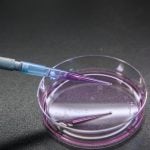A research team has compiled a library of identifiable E. coli DNA patterns in livestock, wildlife and human waste to determine the cause of water contamination, but so far the data has not been able to accurately pinpoint offending species.
Shu Chen, one of three researchers at the University of Guelph who have been mapping these genetic codes for the past six years, said it’s important to know what human or animal may have contaminated water in an effort to prevent future contamination, but finding that information is complicated.
Read Also

Bio-fumigation may become new use for mustard
Mustard is great on hot dogs, but innovators in Western Canada have developed a new mustard variety for a different market — bio-fumigation.
Chen and her colleagues deal with issues of contamination such as disputes between landowners over the cause of contaminated well water or beaches that have to close early due to foul water. The problem could take time to manage if wildlife is the cause, she said, but could be rectified sooner if the culprit were a leaky septic tank or livestock waste runoff from a farm.
Invariably, people “come to the lab and ask for a magic answer,” she said. “We don’t have that yet.”
It was hoped the solution would be found in the university’s DNA tracing library and the best way to trace contamination is to use indicator organisms that in the science world happen to be E. coli.
“Statistically, the science community believes different E. coli from different sources may have different patterns,” said Chen, speculating that thousands, if not millions of E. coli strains have adapted to various animals over time. She said the patterns may have certain components that can be common among animal, humans or wildlife, but each is unique.
“So that’s why we tried to collect as many E. coli isolates as possible, then created a library with the DNA fingerprinting.”
The scientists conducted blind tests with other researchers not involved with the project to see whether pairings could be made between contaminated water samples and DNA indexed in the library.
But it wasn’t the perfect match they had hoped for.
“I would say (there was) agreement perhaps anywhere from 70 to 80 percent,” said Chen.
While the outcome was statistically valid, it wasn’t good enough, she said, especially when identifying water contaminants in legal cases.
Based on the results, Chen doesn’t think the library method of tracing contamination is viable. Because E. coli strains vary by region, she said data would have to be compiled in several locations to effectively identify contamination causes, which wouldn’t be worth the expense.
As a result, it’s back to the drawing board for the research team.
“We have not totally given up, but at the same time we have to develop a better method. So we are actually now trying to find a (new) so-called marker.”
They may have found one, she added, but first it must survive the validation blind test.
Researchers worldwide are working on the same issue and Chen said there is little agreement within the scientific community as to what method will work best for tracing water contamination.














